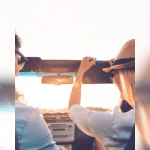Natural light is ambient light from the sun or the moon. Natural light changes constantly; knowledge of sunrise and sunset is crucial for outdoor photography.
“Light is everything,” adventure sports photographer, filmmaker, and mountaineer Jimmy Chin says. “If you can’t control it, you have to be able to anticipate it and know what you want from it.” That means understanding natural light, including the quality, direction, and the changes in natural light throughout the day.
What Is Natural Light in Photography?
Natural light is ambient light supplied by the sun or the moon—not a camera flash or other artificial light. Natural light changes every minute, as the sun move across the sky. That’s why knowing exactly where the sun will rise or set on any given day is incredibly helpful when you’re planning a shoot.
How to Find the Best Natural Light
Knowing exactly where the sun will rise or set on any given day is incredibly helpful when you’re planning a shoot outside or that involves natural light. These apps, which are available for purchase, will tell you the exact sun (and sometimes the moon) position on any day of the year, anywhere on Earth.
The Photographer’s Ephemeris
Sun Surveyor
Sun Seeker
Basics of Lighting
If you’re working with natural (or available) light, you need to have a basic understanding of the quality, direction, and color temperature of light.
Direction
Direction of light refers to the direction which the light falls upon the subject. There are 5 directions of light.
1) Front light
In front light, the subject is lit from the front, giving nice, even light on the subject’s face. It is flattering for portraits because it helps make the subject’s features smaller and wrinkles less noticeable.
2) Back light
In back light, the subject is lit from behind, usually resulting in a silhouette, or else a very blown-out background.
3) Side light
In side lighting, the subject is lit from either the left or the right, which helps to show the texture of your subject.
4) Top light
Top light is generally considered the least flattering type of light, as it can result in “raccoon eyes,” with deep shadows in eye sockets.
5) Under light
In under light, the subject is lit from below. Since light sources are almost always above our heads, when your subject is lit from below it feels quite unnatural—an effect that is usually associated with horror films.
Quality or Intensity
Quality or intensity refers to whether the light is hard or soft.
Hard light is what light looks like on a sunny day, with deep shadows that have crisp, distinct edges. Soft light is what light looks like on a cloudy day, where shadows are much softer, and the edge of the shadow is not distinct. Soft light is great for portraits, because people don’t end up with hard shadows on their faces.
1) Color
Color temperature is less intuitive because our eyes and brains are very good at adjusting to whatever light color we’re seeing to make it look “normal.” It’s easier to be aware of color temperature nowadays, because we can buy different color temperature bulbs to light our homes.
Even though we think of the sun as a constant source of light, the reality is that light changes temperature depending on the time of day (because of the way the light passes through the atmosphere).
- At sunrise, the light is warmer, or yellower.
- At midday, the light is much cooler, a bluish white. This is sometimes considered true white.
- The 30 minutes or so before the sun sets is usually called “golden hour” because the light has a warm, golden hue.
- Blue hour, or twilight, is the half hour after the sun sets, but there’s still light in the sky. The sky will appear quite blue in photos.
Uses for Natural Light
Portrait photography
Natural light can be utilized for portraits, creating a softer, glowing look. When you’re shooting indoors, position your subject’s face near a natural light source, like a window. A front light will smooth out any skin perfections, while a side light will help give your subject dimension. You should also choose simple backgrounds with low contrast, as a busy or high-contrast background will attention away from your portrait’s subject. If natural light becomes unavailable throughout your session, consider keeping a backup lighting setup on standby (more on that below).
When shooting portraits outdoors can be more challenging—but not impossible! Look for soft, even light, which is more accessible in the mornings and evenings, when the sun will hit your subject at an angle. Avoid shooting at midday, when unflattering top light will create harsh shadows on your subject’s face.
Studio
When utilizing natural light in a studio, you’ll need windows. You can’t shoot natural light photography without a source of natural light! Place your subject or object to the side of the window or facing the window for the best, most flattering effect. Avoid backlighting, unless you’re purposely trying to create a silhouette.
Product photography
Natural light is great for photographing products, as artificial light can change the color, while natural light helps preserve it (and keep the white balance in check). When you’re using natural light to shoot products indoors, you’re going to start with the same thing you use for portraits: A window. You should also shoot on a plain white background, as white evenly reflects light.
If you’re in a new location, it will take some trial and error to get used to the light in the space. If the light is too harsh, place a thin white sheet (a diffuser) over the window, to soften the natural light. If a cloud covers the sun and the light dips, use a white foam board or screen (a reflector) to bounce and intensify the light.
Wedding photography
Many wedding photographers choose to use natural light because it gives a softer, more romantic feel to images that artificial lights and flash. Shooting with natural light also requires less gear, which is a major plus when the photographer needs to be moving around a lot to capture shots.
Jimmy’s Pro-Tip for Using Natural Light
If you’re shooting in a situation where the subject is significantly darker than the sky, you’ll likely want to underexpose your image slightly to make sure the sky isn’t blown out to a complete white. You can always brighten your subject later in post production. But if you overexpose the sky and the camera doesn’t record any information because it’s too bright, you won’t be able to recover any information in that part of the image, and the sky will always be a pure white.
How to Fake Natural Light in Photography
If good natural light isn’t available—say it rains on the day of your shoot—it’s possible to fake natural light.
Gather the following or consider purchasing a complete lighting kit:
- Continuous light source
- Light stand
- Diffuse
- Tripod
- Gobo
- Optional: Light modifiers or strobe lighting (if you’re getting experimental)
The first thing you need is continuous lighting. If you have a professional studio light, that’s great! You’ll have more control over the light temperature and other factors with a studio light. But if you’re not ready to invest in a studio lighting yet, a floor lamp will do. You’ll also need to diffuse the harsh artificial light, which can be achieved with a white sheet or other thin piece of white fabric.
It’s a good idea to use a tripod when using studio lights, as you’ll have to turn up the ISO and aperture. Doing so means you need to hold your camera steady, which is much easier to do with a tripod.
You can shoot you subject or object with the diffuse light as-is, or you can use a “gobo” for an even more natural effect. Gobo stands for “go-between” and it’s an object that stands between your light source and your subject, casting shadows to change the quality of the image. A piece of cardboard cut into strips, for example, can imitate the blinds on a window. Play with different angles until you fight the perfect effect.











